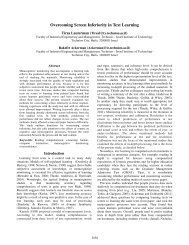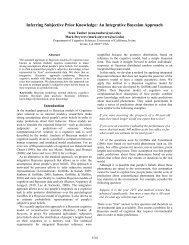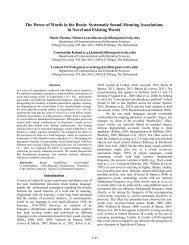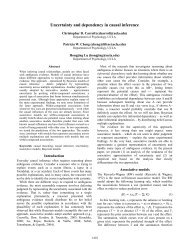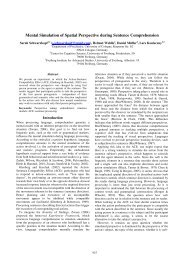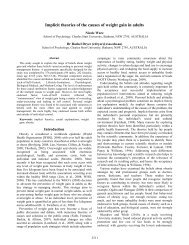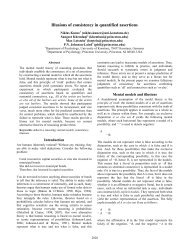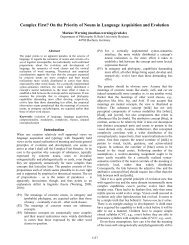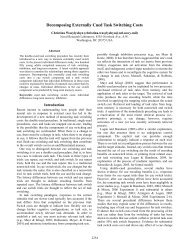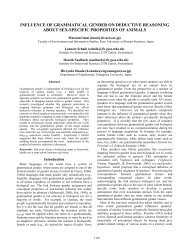A Corpus Analysis of Strategy Video Game Play in Starcraft: Brood ...
A Corpus Analysis of Strategy Video Game Play in Starcraft: Brood ...
A Corpus Analysis of Strategy Video Game Play in Starcraft: Brood ...
You also want an ePaper? Increase the reach of your titles
YUMPU automatically turns print PDFs into web optimized ePapers that Google loves.
<strong>Starcraft</strong>. 6 In the tradition <strong>of</strong> Green and Bavelier, one could<br />
imag<strong>in</strong>e test<strong>in</strong>g subjects for multi-task<strong>in</strong>g capacity before and<br />
after <strong>Starcraft</strong> tra<strong>in</strong><strong>in</strong>g. With these data we could then correlate<br />
any improvement with actual changes <strong>in</strong> their attention/action<br />
distribution <strong>in</strong> the games they played for greater<br />
<strong>in</strong>sight <strong>in</strong>to the learn<strong>in</strong>g process.<br />
Both APM and SVA are useful <strong>in</strong> <strong>Starcraft</strong> due to specific<br />
components <strong>of</strong> its design. With a high APM, one can better<br />
reduce the stochasticity <strong>of</strong> unit movement and take advantage<br />
<strong>of</strong> the unlimited opportunity for action <strong>Starcraft</strong> <strong>of</strong>fers. With<br />
a high SVA, a player reduces the amount <strong>of</strong> uncerta<strong>in</strong>ty due<br />
to <strong>in</strong>complete <strong>in</strong>formation by act<strong>in</strong>g on and reveal<strong>in</strong>g more<br />
areas <strong>of</strong> the map. In a game that does not have these design<br />
characteristics, such as Chess, APM and SVA should have no<br />
correlation to w<strong>in</strong> rates. Clearly Chess players do not practice<br />
the physical act <strong>of</strong> mov<strong>in</strong>g pieces on the board–there’s<br />
no need. Even <strong>in</strong> Speed Chess the emphasis is on quickly<br />
develop<strong>in</strong>g a strategy and determ<strong>in</strong><strong>in</strong>g the current s<strong>in</strong>gle best<br />
move, not on physically execut<strong>in</strong>g a large number <strong>of</strong> moves<br />
<strong>in</strong> a short time span. If one were manag<strong>in</strong>g a disaster, though,<br />
high APM should lead to <strong>in</strong>creased performance (e.g. check<strong>in</strong>g<br />
<strong>in</strong> <strong>of</strong>ten with workers <strong>in</strong> the field, issu<strong>in</strong>g <strong>in</strong>structions,<br />
etc.), s<strong>in</strong>ce the task has similar taxonomic characteristics.<br />
These replay data, which constitute simply a list <strong>of</strong> actions<br />
undertaken by each player, are only a subset <strong>of</strong> the quantitative<br />
data that could be gathered on <strong>Starcraft</strong> play (though<br />
they are the only data suitable for a large scale corpus analysis<br />
such as this). With access to players and their mach<strong>in</strong>es,<br />
one could imag<strong>in</strong>e collect<strong>in</strong>g eye movements, mouse traces,<br />
more detailed game state (e.g. changes <strong>in</strong> material, visual<br />
complexity), first person video and audio and hand and body<br />
movements. We have developed a simple application to measure<br />
visual complexity with first person video, and we would<br />
like to cont<strong>in</strong>ue develop<strong>in</strong>g tools to allow a more f<strong>in</strong>e-gra<strong>in</strong>ed<br />
<strong>in</strong>vestigation <strong>of</strong> <strong>Starcraft</strong> play.<br />
This study develops a novel methodology for analyz<strong>in</strong>g<br />
video game play <strong>in</strong> the wild. Through an analysis <strong>of</strong> over<br />
2,000 competitive <strong>Starcraft</strong> games, we show that the ability<br />
to change the game state more frequently, and to distribute<br />
one’s attention and actions around to map leads to success<br />
<strong>in</strong> the game. S<strong>in</strong>ce <strong>Starcraft</strong> shares structure with important<br />
endeavors such as disaster management and air traffic control,<br />
we believe that a better understand<strong>in</strong>g <strong>of</strong> what improves<br />
<strong>Starcraft</strong> play can lead to better tra<strong>in</strong><strong>in</strong>g for other challeng<strong>in</strong>g<br />
tasks.<br />
6 One could argue that a player tak<strong>in</strong>g action over a larger area <strong>of</strong><br />
the map controls a larger area and is thus more likely to w<strong>in</strong> because<br />
they are already ahead. While some games <strong>of</strong> <strong>Starcraft</strong> are won<br />
by build<strong>in</strong>g more bases and a larger economy than one’s opponent,<br />
other common strategies <strong>in</strong>volve strong attacks <strong>of</strong>f <strong>of</strong> one or two<br />
bases while the opponent is attempt<strong>in</strong>g to take more <strong>of</strong> the map.<br />
Thus we do not th<strong>in</strong>k that the SVA f<strong>in</strong>d<strong>in</strong>g is solely the result <strong>of</strong> map<br />
control.<br />
692<br />
Acknowledgments<br />
Thanks to Darren Lou and Mohamed Mirza for their valuable<br />
assistance on this project. Thanks to András Belicza for develop<strong>in</strong>g<br />
the Java replay analysis package we used to collect<br />
the data, and k<strong>in</strong>dly answer<strong>in</strong>g our questions.<br />
References<br />
Belicza, A. (2011). <strong>Starcraft</strong> <strong>Brood</strong>war<br />
hacker f<strong>in</strong>der, anti-hack, replay analyzerorganizer<br />
and utility tool. Available from<br />
http://code.google.com/p/bwhf/source/browse/<br />
Brand, J., Knight, S., & Majewski, J. (2003). The diverse<br />
worlds <strong>of</strong> computer games: A content analysis <strong>of</strong> spaces,<br />
populations, styles and narratives. In Level up: Digital<br />
games research conference. Utrecht, Netherlands: Digital<br />
<strong>Game</strong>s Research Association.<br />
Crecente, B. (2009). Competitive <strong>Starcraft</strong> gets UC Berkeley<br />
class. Available from http://kotaku.com/5141355/<br />
competitive-starcraft-gets-uc-berkeley-class<br />
Douglass, J. (2009). Computer visions <strong>of</strong> computer games:<br />
analysis and visualization <strong>of</strong> play record<strong>in</strong>gs. In Workshop<br />
on media arts, science, and technology (mast) 2009: The<br />
future <strong>of</strong> <strong>in</strong>teractive media. UC Santa Barbara.<br />
Expressive Intelligence Studio. (2010). <strong>Starcraft</strong><br />
AI competition. Available from<br />
http://eis.ucsc.edu/StarCraftAICompetition<br />
Green, C. S., & Bavelier, D. (2003). Action video game<br />
modifies visual selective attention. Nature, 423, 534–537.<br />
Green, C. S., & Bavelier, D. (2006). Effect <strong>of</strong> action video<br />
games on the spatial distribution <strong>of</strong> visuospatial attention.<br />
Journal <strong>of</strong> Experimental Psychology: Human Perception<br />
and Performance, 32(6), 1465 - 1478.<br />
Huang, H. (2011). Skynet meets the swarm:<br />
how the Berkeley Overm<strong>in</strong>d won the 2010<br />
<strong>Starcraft</strong> AI competition. Available from<br />
http://arstechnica.com/gam<strong>in</strong>g/news/2011/01/<br />
skynet-meets-the-swarm-how-the-berkeleyoverm<strong>in</strong>d-won-the-2010-starcraft-aicompetition.ars/<br />
Kirsh, D., & Maglio, P. (1994). On dist<strong>in</strong>guish<strong>in</strong>g epistemic<br />
from pragmatic action. Cognitive Science, 18, 513–549.<br />
Malliet, S. (2007). Adapt<strong>in</strong>g the pr<strong>in</strong>ciples <strong>of</strong> ludology to the<br />
method <strong>of</strong> video game content analysis. <strong>Game</strong> Studies, 7.<br />
Smith, S. L., Lachlan, K., & Tambor<strong>in</strong>i, R. (2003). Popular<br />
video games: Quantify<strong>in</strong>g the presentation <strong>of</strong> violence and<br />
its context. Journal <strong>of</strong> Broadcast<strong>in</strong>g and Electronic Media,<br />
47, 58–76.





